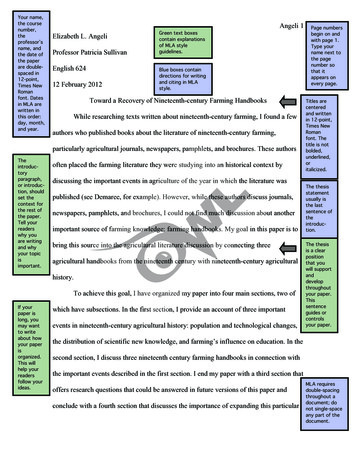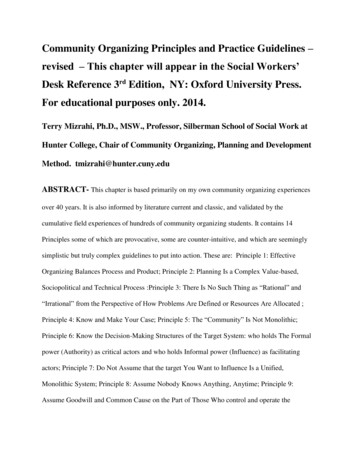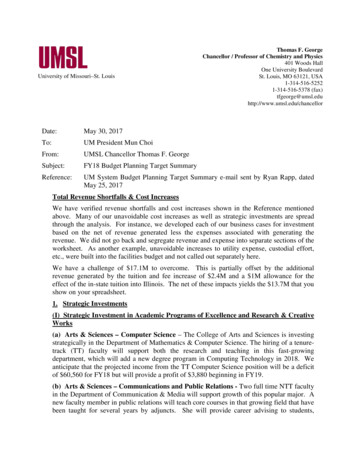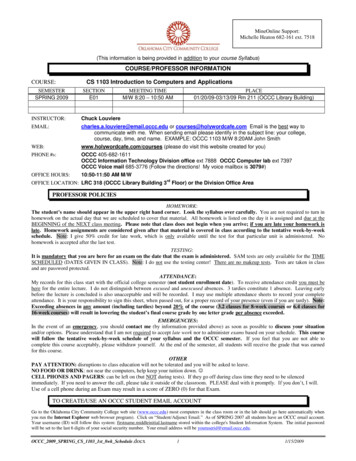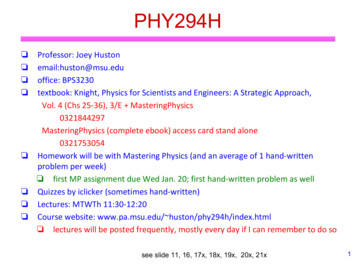
Transcription
PHY294H Professor: Joey Hustonemail:huston@msu.eduoffice: BPS3230textbook: Knight, Physics for Scientists and Engineers: A Strategic Approach,Vol. 4 (Chs 25-36), 3/E MasteringPhysics0321844297MasteringPhysics (complete ebook) access card stand alone0321753054Homework will be with Mastering Physics (and an average of 1 hand-writtenproblem per week) first MP assignment due Wed Jan. 20; first hand-written problem as wellQuizzes by iclicker (sometimes hand-written)Lectures: MTWTh 11:30-12:20Course website: www.pa.msu.edu/ huston/phy294h/index.html lectures will be posted frequently, mostly every day if I can remember to do sosee slide 11, 16, 17x, 18x, 19x, 20x, 21x1
Electric field from a point chargeI put my (imaginary) test chargeqo at some point in space, and Imeasure the forceI can then determine the electricfield from the point charge qThe electric field that I measurehas nothing to do with the testcharge qo it’s there whether or not Iuse a test charge tomeasure it2
Electric field from a point charge Thus,the electric field from thepoint charge q is3
The unit vector, r-hatDefine a unit vector r which points away from the charge.Note thatE fieldvectors aredrawn largerat pointscloser tothe charge(because E is larger)so electric field points away from chargeand towards – charge4
Shape of the electric field function1q Eq 4π ε0 r2The electric field from apoint chargegoes to infinity as r 0;and it goes to 0 as r 5
At which point is the electricfield stronger?A. Point A.B. Point B.C. Not enough information to tell.6
At which point is the electricfield stronger?A. Point A.B. Point B.C. Not enough information to tell.7
QuickCheck 26.1What is the direction ofthe electric field at theblack dot?A.B.C.D.E.A.B.C.D.None of these.8
QuickCheck 26.1What is the direction ofthe electric field at theblack dot?9Slide 26-23
What if I have more than 1 charge? What is the electric field at the center of thesquare?q1q2E E 1 E2 E3 E4 Note that this is avector addition ofthe electric fieldsfrom all 4 charges.Xq31mq410
What if I have more than 1 charge? Suppose q1q1 2 μCq2 3 μCq3 3 μCq4 2 μCq2E4XE1E2E3q3q411
What if I have more than 1 charge?Now put a charge q ( 1 µC)at the center of the square?q1q2What is the force acting onthe charge?F qEq E 108,000 N/CE F 0.108 NFq3q412
What if I have more than 1 charge?What if I put a charge q ( 1 µC)at the center of the square?What is the force acting on thecharge?q1q2The electric field from thecharges on the square has notchanged.FqThe force on q is in the oppositedirection as the electric fieldsince q is negative; samemagnitude as before, though.Eq3q413
What if I have more than 1 charge? What if I change thevalue of q3? q1q2q1 2 μCq2 3 μCq3 3 μCq4 2 μCWhat is the value of Eat the center?X What is the value of Fon a charge q that I put atthe center?q3q414
Electric fields to know and love Four different situations shown tothe right will often be encounteredin the problems you’ll be solvingfor this course (and even in reallife) or even if the problem doesn’tquite look like one of these, youcan make some approximations For example, if I get very far awayfrom a (finite) charge distribution,I should find an electric field thatlooks like that due to a pointcharge this is a good limitingcircumstance to take to see ifyou’ve done a calculationcorrectlyAll these cases have a lot of symmetry.Remember that when we get to Gauss’ Law.15
Electrical dipoles We’ve encountered electricdipoles before, either inducedor permanent. Now we can calculate theelectric field from a dipole let’s set it up on the blackboard16
Dipole momentsp qs Define the dipole moment p see the figure p is a vector p q s Then we can write the formulafor the electric field of a dipoleon the axis of the dipole asEdipole 12p4π ε0 r3Note that the dipole electric field drops off as 1/r3 rather than the1/r2 of a point charge.17
Electric dipole Along the x axis, the generalformula for the electric fieldfrom a dipole isEdipole 1p4π ε0 r3 This is opposite the direction ofthe dipole moment, and half ofthe magnitude of the fieldalong the y-axis18
Remember the demo/calculation with the water In the water molecule there is aneffective separation of and charge by3.9 X 10 11 m So now we can say it has a dipolemoment p (1.6 X 10 19 C) (3.9 X 10 11m) 6.2 X 10-30 C.m We can calculate the electric field on thedipole axis according to the formula onthe previous pageEdipole 12p4π ε0 r3 2 cm away from the molecule, the E fieldhas a value of 1.4 X 10-14 N/C .Suppose we transferred 1E9 electronsfrom the rod by rubbing it with the silk.There are equal but opposite forces onthe glass rod and on the molecule.F(on the rod) qrod Edipole (1.6 X 10-10 C) (1.4 X 10-14 N/C) 2.24 X 10-24 N19
Electric field from 3 equal point charges In general, Enet E1 E2 E3 I can start by simplifying (forthis problem) no component along zdirection so Ez 0 (E3)y and (E1)y will canceleach other out so there isonly a component alongthe x direction (Enet)x (E1)x (E2)x (E3)x 2(E1)x (E2)xEnet q4π ε0[12x x2(x2 d2)3/2] i Far from the charges20
Limiting casesqEnet 4π ε0[12x x2(x2 d2)3/2] i21
Electric Field Lines . indicate the direction and magnitudeof the electric field in a region of spaceCan we actually see the field lines? No, but .22
Single Point Charge23
Electric Dipole24
2 equal positive charges25
Drawing and interpreting electric field lines Pretty useful idea but we need someguidelineselectric field lines point in direction offield at that point in spacethe total number of electric field lines isproportional to the size of the chargeclose to an electric charge, the field lineslook like that due to the point chargealonethe density of field lines is proportional tothe strength of the electric fieldelectric field lines originate on chargesand terminate on - chargesno 2 field lines can cross in free space don’t cross the streams26
textbook: Knight, Physics for Scientists and Engineers: A Strategic Approach, Vol. 4 (Chs 25-36), 3/E MasteringPhysics 0321844297 MasteringPhysics (complete ebook) access card stand alone 0321753054 Homework will be with Mastering Physics (and an average of 1 hand-written problem per week) first MP assignment due Wed Jan. 20; first hand-written problem as well Quizzes by iclicker




